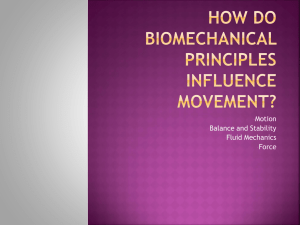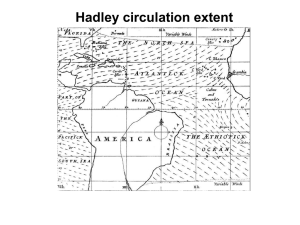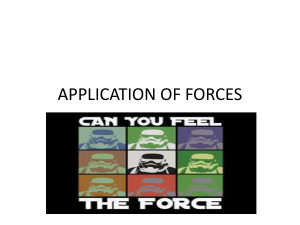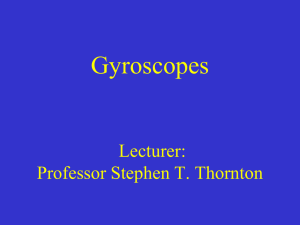J 2
advertisement
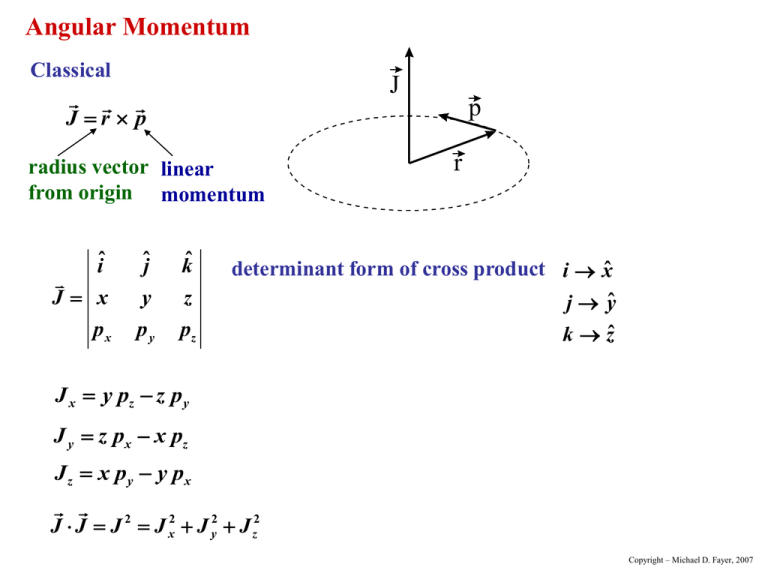
Angular Momentum Classical J p J r p radius vector linear from origin momentum iˆ J x px ˆj y py kˆ z pz r determinant form of cross product i xˆ j yˆ k zˆ J x y pz z p y J y z px x pz J z x p y y px J J J 2 J x2 J y2 J z2 Copyright – Michael D. Fayer, 2007 Q.M. Angular Momentum In the Schrödinger Representation, use Q.M. operators for x and p, etc. x P x= i x=x Substituting J i iˆ ˆj kˆ x y z x y z J x i y z z y J z i x y y x J y i z x x z J J Jx J y Jz 2 2 2 Copyright – Michael D. Fayer, 2007 Commutators Consider J x , J y J x J y J y J x substituting operators in units of J x J y y z z x z y x z y z y x z z z x z x z z y x y z Similarly J y J x z y z z x y x z x y z z z y x z Subtracting J x , J y y z z x z z z y z z x z Copyright – Michael D. Fayer, 2007 J x , J y y z z x z z z y z z x z y x , z y z x x y , z x z y iJz , z z But Therefore, z , z 1 1 1 P , z 1 z, P z z i i J x , J y i J z J x , J y i J z because 1 i i P z z i Using z , P z i 1 in conventional units Copyright – Michael D. Fayer, 2007 The commutators in units of are J x , J y i J z J y , J z i J x J z , J x i J y . Using these it is found that J 2 , J z J 2 , J x J 2 , J y 0 Components of angular momentum do not commute. J2 commutes with all components. Copyright – Michael D. Fayer, 2007 Therefore, J2 and one component of angular momentum can be measured simultaneously. Call this component Jz. Therefore, J2 and Jz can be simultaneously diagonalized by the same unitary transformation. Furthermore, H,J 0 (J looks like rotation) Therefore, H,J 2 0 H, J2, Jz are all simultaneous observables. Copyright – Michael D. Fayer, 2007 Diagonalization of J2 and Jz J2 and Jz commute. Therefore, set of vectors m are eigenvectors of both operators. J 2 and J z are simultaneously diagonal in the basis m J m m 2 Jz m m m (in units of ) Copyright – Michael D. Fayer, 2007 Form operators J J x i J y J J x i J y From the definitions of J and J and the angular momentum commutators, the following commutators and identities can be derived. Commutators J , J z J J , J z J J , J 2J z Identities JJ J Jz Jz 2 2 JJ J Jz Jz 2 2 Copyright – Michael D. Fayer, 2007 Expectation value m J m m Jz m 2 2 Because m J m m Jz m m Jx m m J y m 2 2 2 2 Positive numbers because J’s are Hermitian – give real numbers. Square of real numbers – positive. Therefore, the sum of three positive numbers is great than or equal to one of them. Now m J m 2 m J z m m2 2 Therefore, m2 Eigenvalues of J2 is greater than or equal to square of eigenvalues of Jz. Copyright – Michael D. Fayer, 2007 Using J , J z J JzJ JJz J Consider J z J m J J z m J m J m m J m m 1 J m eigenvalue Furthermore, J 2 , J 0 Then eigenvector J2 commutes with J+ because it commutes with Jx and Jy. J J m J J m J m eigenvalue 2 2 eigenvector Copyright – Michael D. Fayer, 2007 Thus, J m is eigenvector of Jz with eigenvalue m + 1 and of J2 with eigenvalue . J+ is a raising operator. It increases m by 1 and leaves unchanged. Copyright – Michael D. Fayer, 2007 Repeated applications of J to m gives new eigenvectors of Jz (and J2) with larger and larger values of m. But, this must stop at a largest value of m, mmax because m2 . (m increases, doesn’t change) Call largest value of m (mmax) j. mmax = j For this value of m, that is, m = j J j 0 with j 0 Can’t raise past max value. Copyright – Michael D. Fayer, 2007 In similar manner can prove J m is an eigenvector of J z with eigenvalues m – 1 and of J2 with eigenvalues . Therefore, J is a lowering operator. It reduces the value of m by 1 and leaves unchanged. Operating J repeatedly on j J j largest value of m gives eigenvectors with sequence of m eigenvalues m j , j 1, j 2, Copyright – Michael D. Fayer, 2007 But, m2 Therefore, can’t lower indefinitely. Must be some j such that J j 0 with j 0 Smallest value of m. Can’t lower below smallest value. Thus, j = j' + an integer. largest value of m Went from largest value to smallest value in unit steps. smallest value of m Copyright – Michael D. Fayer, 2007 We have largest value of m J j 0 J j 0 smallest value of m Left multiplying top equation by J and bottom equation by J JJ j 0 2 identities J J j 0 Then JJ J Jz Jz 2 JJ J Jz Jz 2 0 J 2 J j JJ j 0 J Jz Jz j J J j and operating 2 2 2 Jz 2 z J J j 0 j2 j j J J j 0 j 2 j j Copyright – Michael D. Fayer, 2007 J J j 0 j2 j j J J j 0 j 2 j j Because j 0 and j 0 the coefficients of the kets must equal 0. Therefore, j ( j 1) and ( j)( j 1) Because j > j' j j and 2j = an integer because we go from j to j' in unit steps with lowering operator J . Thus, the eigenvalues of J2 are j ( j 1) and The eigenvalues of Jz are largest m j 0, 1 3 , 1, , 2 2 m j , j 1, (largest m for a ) , j 1, j change by unit steps smallest value of m Copyright – Michael D. Fayer, 2007 Final results J 2 jm j ( j 1) j m Jz jm m jm There are (2j + 1) m-states for a given j. Can derive J jm j m jm1 j m1 J jm jm j m1 jm 1 Copyright – Michael D. Fayer, 2007 Angular momentum states can be grouped by the value of j. Eigenvalues of J2, = j(j + 1). j 0, 1/2, 1, 3/2, 2, j0 m0 00 j 1/2 m 1/2, 1/2 1 1 2 2 j 1 m 1, 0, 1 1 1 1 0 1 1 j 3/2 m 3/2, 1/2, 1/2, 3/2 3 3 2 2 j2 22 m 2, 1, 0, 1, 2 1 1 2 2 31 2 2 21 3 1 2 2 20 3 3 2 2 2 1 2 2 etc. Copyright – Michael D. Fayer, 2007 Eigenvalues of J 2 are the square of the total angular momentum. The length of the angular momentum vector is j ( j 1) j ( j 1) or in conventional units Example j=1 Eigenvalues of Jz are the projections of the angular momentum on the z axis. z m=1 2 m=0 m = -1 Copyright – Michael D. Fayer, 2007 The matrix elements of J jm J 2 2 J z J J are jm j ( j 1) jj m ,m j m J z jm m jj m ,m jm J jm j m j m 1 m,m 1 jm J jm j m j m 1 m,m 1 jj jj The matrices for the first few values of j are (in units of ) j = 1/2 j = 0 J (0) J (0) J z (0) J (0) 0 1 J 0 0 0 0 J 1 0 2 3 0 1/2 2 4 J Jz 0 0 1/2 0 3 4 Copyright – Michael D. Fayer, 2007 j = 1 0 J 0 0 2 0 0 0 0 2 J 2 0 0 1 0 0 Jz 0 0 0 0 0 1 0 0 2 0 0 0 2 0 0 2 J 0 2 0 0 0 2 The j m are eigenkets of the J 2 and J z operators – diagonal matrices. The raising and lowering operators J and J have matrix elements one step above and one step below the principal diagonal, respectively. Copyright – Michael D. Fayer, 2007 Particles such as atoms R( r )Y m ( , ) spherical harmonics from solution of H atom The Y m ( , ) are the eigenvectors of the operators L2 and Lz. The Y m ( , ) j m m L Y m ( , ) ( 1)Y m ( , ) 2 L z Y m ( , ) mY m ( , ) Copyright – Michael D. Fayer, 2007 Addition of Angular Momentum Examples Orbital and spin angular momentum - and s. These are really coupled – spin-orbit coupling. NMR – one proton spin coupled to another. Not independent. ESR – electron spins coupled to nuclear spins Inorganic spectroscopy – unpaired d electrons Molecular excited triplet states – two unpaired electrons Could consider separate angular momentum vectors j1 and j2. These are distinct. But will see, that when they are coupled, want to combine the angular momentum vectors into one resultant vector. Copyright – Michael D. Fayer, 2007 Specific Case j1 1 2 m1 1 2 j2 1 2 m2 1 2 Four product states j1 m1 j2 m2 1 1 1 1 2 2 2 2 m1m2 1 1 1 1 2 2 2 2 1 1 1 1 2 2 2 2 1 1 1 1 2 2 2 2 1 1 2 2 j1 and j2 omitted because they are always the same. 1 1 2 2 Called the m1m2 representation 1 1 2 2 The two angular momenta are considered separately. 1 1 2 2 Copyright – Michael D. Fayer, 2007 m1 m 2 j1 j2 m1 m2 Want different representation m1m2 representation Unitary Transformation to coupled rep. Angular momentum vectors added. New States labeled jm j1 j2 jm jm jm representation Copyright – Michael D. Fayer, 2007 jm Eigenkets of operators J 2 and Jz where J J1 J 2 J z J 1z J 2 z J 2 jm j j 1 jm vector sum of j1 and j2 J z jm m jm Want unitary transformation from the m1m2 representation to the jm representation. Copyright – Michael D. Fayer, 2007 Want jm C m1m2 m1m2 m1m2 C m1m2 m1 m2 jm Cm1m2 are the Clebsch-Gordan coefficients; Wigner coefficients; vector coupling coefficients m1 m 2 are the basis vectors N states in the m1m2 representation N states in the jm representation. N (2 j1 1)(2 j2 1) J2 and Jz obey the normal commutator relations. Prove by using J J 1 J 2 and cranking through commutator relations using the fact that J1 and J2 and their components commute. Operators operating on different state spaces commute. Copyright – Michael D. Fayer, 2007 Finding the transformation J z J 1z J 2 z m m1 m2 or coupling coefficient vanishes. To see this consider jm C m1m2 m1m2 m1m2 Operate with Jz equal J z jm m jm J 1 z J 2 z Cm1m2 m1m2 m1m2 These must be equal. Other terms C m1m2 0 m 1 m2 Cm1m2 m1m2 m1m2 if m1 m2 m Copyright – Michael D. Fayer, 2007 Largest value of m m j1 + j2 m1max m2max since largest m1 j1 and m2 j2 Then the largest value of j is j j1 j2 because the largest value of j equals the largest value of m. There is only one state with the largest j and m. There are a total of (2j + 1) m states associated with the largest j j1 j2 . Copyright – Michael D. Fayer, 2007 Next largest m (m – 1) m j1 j2 1 But m m1 m2 Two ways to get m - 1 m1 j1 and m2 j2 1 m1 j1 1 and m2 j2 Can form two orthogonal and normalized combinations. One of the combinations belongs to j j1 j2 Because this value of j has m values m ( j1 j2 ), ( j1 j2 1), ,( j1 j2 ) Other combination with m j1 j2 1 j j1 j2 1 with m ( j1 j2 1), ( j1 j2 2), largest ,( j1 j2 1) smallest Copyright – Michael D. Fayer, 2007 Doing this repeatedly j values from j j1 j2 to j1 j2 in unit steps Each j has associated with it, its 2j + 1 m values. Copyright – Michael D. Fayer, 2007 Example j1 1 , 2 j2 1 2 j j1 j2 to j1 j2 j values j 1 1 1 2 2 j 1 1 0 2 2 j 1 m 1, 0, 1 j0 m0 jm rep. kets 11 , 1 0 , 0 0 , 1 1 m1m2 rep. kets 11 1 1 1 1 1 1 , , , 22 2 2 2 2 2 2 Know jm kets still need correct combo’s of m1m2 rep. kets Copyright – Michael D. Fayer, 2007 Generating procedure Start with the jm ket with the largest value of j and the largest value of m. 11 J z 11 1 11 But m = 1 m m1 m2 Therefore, 1 1 m2 2 2 because this is the only way to get m1 m1 m2 1 Then 11 jm 1 1 2 2 m 1 m2 Clebsch-Gordan coefficient = 1 Copyright – Michael D. Fayer, 2007 Use lowering operators J J 1 J 2 jm m 1 m2 11 1 1 2 2 jm m 1 m2 J 11 2 10 from lowering op. expression J 1 J 2 11 11 11 J 1 J 2 22 22 22 1 1 1 1 1 1 2 2 2 2 Then 10 1 1 1 1 1 1 2 2 2 2 2 2 Clebsch-Gordan Coefficients from lowering op. expression (Use correct ji and mi values.) Copyright – Michael D. Fayer, 2007 Plug into raising and lowering op. formulas correctly. J jm j m jm1 j m1 J jm jm j m1 jm 1 For jm rep. plug in j and m. For m1m2 rep. m1 m2 jm m1 m 2 means j1 j2 m1m2 For J 1 and J 2 must put in j1 and m1 when operating with J 1 and j2 and m2 when operating with J 2 Copyright – Michael D. Fayer, 2007 Lowering again J 1 0 2 1 1 m1 m2 J 1 J 2 m1 m2 1 1 1 1 1 2 2 2 2 2 1 1 1 1 1 1 00 2 2 2 2 2 2 Therefore, 1 1 jm 1 1 2 2 m 1 m2 Have found the three m states for j = 1 in terms of the m1m2 states. Still need 00 m 0 m1 m2 Copyright – Michael D. Fayer, 2007 Need jm 00 m0 m1 m2 0 Two m1m2 kets with m1 m2 0 1 1 11 , 2 2 22 The 0 0 is a superposition of these. Have already used one superposition of these to form 10 10 1 1 1 1 1 1 2 2 2 2 2 2 0 0 orthogonal to 10 and normalized. Find combination of 1 1 , 1 1 normalized and orthogonal to 10 . 2 2 22 1 1 1 1 1 1 00 2 2 2 2 2 2 Clebsch-Gordan Coefficients Copyright – Michael D. Fayer, 2007 Table of Clebsch-Gordan Coefficients 1 1 j1=1/2 j2=1/2 1 1 2 1 2 1 1 0 0 0 1 1 1 2 1 2 1 2 1 2 1 2 1 2 1 2 2 2 2 m1 m2 1 j 1 m 1 Copyright – Michael D. Fayer, 2007 Next largest system 1 2 1 1 m2 , 2 2 j1 1 j2 m1 1,0, 1 m1m2 kets 1 1 2 1 1 2 0 1 2 0 1 2 1 1 2 1 1 2 jm states j j1 j2 3 2 m j j1 j2 1 2 m jm kets 33 22 3 1 1 3 , , , 2 2 2 2 31 22 1 1 , 2 2 3 1 2 2 3 3 2 2 11 22 1 1 2 2 Copyright – Michael D. Fayer, 2007 Table of Clebsch-Gordan Coefficients 3 2 3 2 1 2 3 2 1 2 1 2 1 2 1 3 2 3 0 1 2 2 3 0 2 1 2 3 1 1 2 1 3 j1 = 1 j 2 = 1/2 1 2 1 1 3 2 1 2 1 2 1 2 3 2 j 3 2 m 1 1 3 1 3 2 3 1 1 2 1 m1 m2 jm Example 11 22 m1 m2 m1 m2 2 1 1 1 1 0 3 2 3 2 Copyright – Michael D. Fayer, 2007


